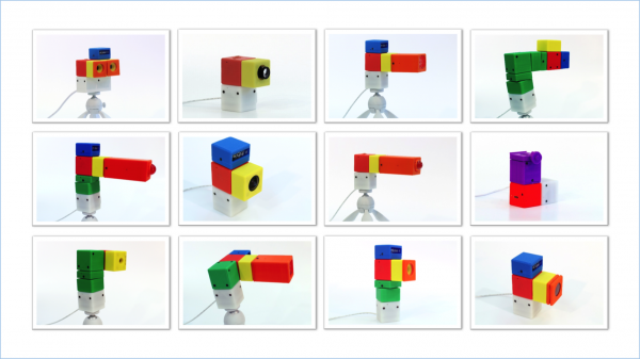Feb 16 2016
Computer Science Professor Shree Nayar and Makoto Odamaki, a visiting scientist from Ricoh Corporation, have developed Cambits, a modular imaging system that enables the user to create a wide range of computational cameras. Cambits comprises a set of colorful plastic blocks of five different types—sensors, light sources, actuators, lenses, and optical attachments.
The blocks can easily be assembled to make a variety of cameras with different functionalities such as high dynamic range imaging, panoramic imaging, refocusing, light field imaging, depth imaging using stereo, kaleidoscopic imaging and even microscopy.
 Cameras made with Cambits. Cambits, a modular imaging system that can transform into many different cameras, has been developed by Columbia Engineering Computer Science Professor Shree Nayar and Makoto Odamaki, visiting scientist from Ricoh Corporation. Credits: Shree Nayar/Columbia Engineering
Cameras made with Cambits. Cambits, a modular imaging system that can transform into many different cameras, has been developed by Columbia Engineering Computer Science Professor Shree Nayar and Makoto Odamaki, visiting scientist from Ricoh Corporation. Credits: Shree Nayar/Columbia Engineering
“We wanted to redefine what we mean by a camera,” says Nayar, who is the T.C. Chang Professor of Computer Science at Columbia Engineering and a pioneer in the field of computational imaging. “Traditional cameras are really like black boxes that take one type of image. We wanted to rethink the instrument, to come up with a hardware and software system that is modular, reconfigurable, and able to capture all kinds of images. We see Cambits as a wonderful way to unleash the creativity in all of us.”
Cambit blocks, whose exteriors were 3D-printed, are easy and quick to configure. They are attached through magnets: no screws, no cables. When two blocks are attached, they are electrically connected by spring-loaded pins. The pins carry the power (from a host computer, tablet, or smartphone), data, and control signals.
Each block has an ID and when a set of blocks are put together, the host computer recognizes the current configuration and provides a menu of options for what the user might want to do. Cambits is scalable: new blocks can be added to the existing set.
A key aspect of the Cambits design is a circuit board designed by Odamaki that sits inside each block. The board includes a microcontroller, an upstream interface, and a downstream interface. Through the circuit, each block can provide power downstream and receive data upstream. Control signals are conveyed both up and downstream.
“Using our novel architecture, we were able to configure a wide range of cameras,” adds Odamaki, who spent two years working with Nayar on the proof-of-concept project. The suite of computational photography algorithms used by Cambits was implemented by a group of MS project students at Columbia Engineering. Odamaki and Nayar are hoping to partner with a manufacturer to bring their concept to the public.
“There are so many exciting advances in computational photography these days,” Nayar adds. “We hope this reconfigurable system will open the door to new avenues of creativity, bringing new dimensions to an art form we all enjoy.”